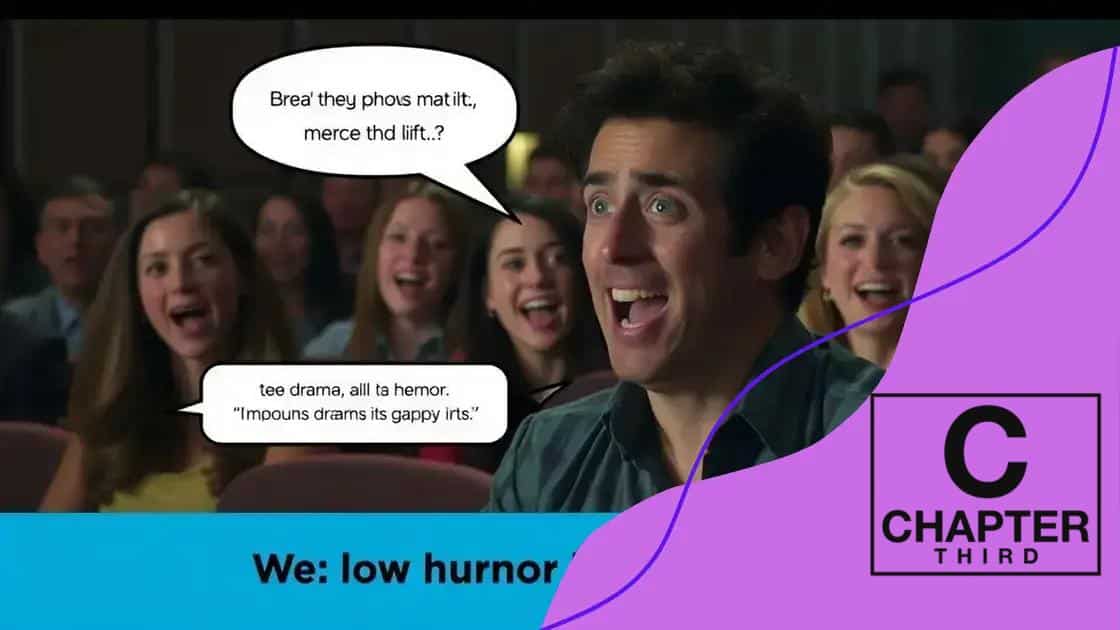Humor to relieve dramatic tension in storytelling

Balancing humor and drama in storytelling enhances emotional engagement, providing relief during tense moments while deepening audience connections with characters and making narratives more memorable.
Humor to relieve dramatic tension plays a crucial role in storytelling. Ever noticed how a well-placed joke can lighten a heavy moment? This art of balancing laughter and seriousness keeps audiences captivated and invested.
Understanding the role of humor in storytelling
Understanding the role of humor in storytelling is crucial for captivating your audience. Humor can create memorable moments and add depth to characters and situations.
When used effectively, humor breaks the tension and allows the audience to connect. There are various forms of humor, each serving a distinct purpose in storytelling. These can include:
Types of Humor in Storytelling
- Witty dialogue that showcases character personality.
- Situational humor that arises from unexpected scenarios.
- Physical comedy that relies on visual gags and actions.
Each of these types enhances your narrative by providing relief during tense moments. For instance, a character’s sarcastic remarks can lighten a serious scene, giving the audience a breather. This balance is essential in creating an engaging story.
Another important aspect to consider is the timing of humor. A well-timed joke can elevate the emotional impact of a scene. If it’s placed just after a dramatic tension, it can be incredibly effective. Think about the last movie you watched where humor made the serious moments more impactful. Timing is everything.
Impact of Humor on Audience Engagement
Humor draws audiences in. It invites them to share in the experience and feel connected to the characters. When characters face adversity, a sprinkle of humor can make them relatable.
- It fosters connection between characters and the audience.
- It enhances emotional responses during pivotal scenes.
- It offers a unique voice to the narrative.
In conclusion, humor plays a foundational role in storytelling. By weaving it into your narrative, you create a delightful balance that resonates with your audience. Embracing the art of humor can transform the way your story is experienced, making it not just enjoyable, but unforgettable.
How humor impacts emotional engagement
Humor plays a significant role in how the audience engages emotionally with a story. It’s a powerful tool that can transform feelings and create connections.
When humor is present, it lightens the mood, making way for deeper emotional experiences. This contrasts with tension and conflict, which can sometimes overwhelm an audience. By introducing humor, you allow space for relief and connection. Humor enables the audience to empathize with characters more easily.
The Bridge Between Characters and Audience
Humor acts as a bridge that connects characters with the audience. When characters make jokes or find themselves in funny situations, it humanizes them. Audiences relate to characters who show vulnerability through humor. Here are some effects of humor on emotional engagement:
- **Encourages empathy** by showcasing characters’ flaws in a lighthearted way.
- **Fosters relatability**, as audiences see parts of themselves in humorous situations.
- **Enhances tension release**, allowing viewers to experience a range of emotions.
Just picture a moment in a film where a character faces a crisis but suddenly cracks a joke. It doesn’t diminish the weight of the situation but rather gives the audience a moment to breathe. The laughter becomes a relief, reinforcing their emotional investment.
Creating Lasting Impressions
Humor also leaves a lasting impression, making stories more memorable. People often recall the funniest moments from a narrative. These moments create touchpoints that stick in the mind long after the story ends. The relationship between humor and memory is essential for storytelling.
- **Elevates storytelling** by creating highlights that audiences remember.
- **Transforms ordinary scenes** into extraordinary experiences through laughter.
- **Cultivates a positive atmosphere**, enhancing the overall enjoyment of the story.
Integrating humor effectively prompts a more profound response from the audience. It can shift the atmosphere from serious to light-hearted seamlessly, adding depth to the story.
Examples of humor alleviating tension

Examples of humor alleviating tension can be found in various forms of storytelling, from films to theater and novels. Humor serves as a release valve, allowing audiences to process emotions without feeling overwhelmed.
In many stories, key moments of tension are immediately followed by humorous interactions. This technique not only provides relief but also strengthens the connection with the characters. Consider a suspenseful scene where a character faces danger. Just when the tension peaks, a humorous line or action can create a sudden shift. This technique reminds viewers that there’s always room for laughter.
Classic Instances in Film
Classic films often use humor to navigate dramatic situations. Movies like The Princess Bride masterfully incorporate wit during tense moments.
- Funny banter: Characters exchange quick quips even in perilous situations.
- Physical comedy: Slapstick moments lighten serious scenes.
- Unexpected humor: A character finds themselves in an absurd situation that provides comic relief.
Such moments illustrate how humor can act as a lifeline, allowing characters and audiences to breathe during intense narratives.
Literary Examples
Literature also features humor that alleviates tension. In many novels, authors inject light-hearted moments amidst the drama. For instance, in Jane Austen‘s works, characters often engage in playful dialogues, alleviating the tension from their societal constraints.
- Witty observations: Characters comment on each other in humorous ways.
- Comic situations: Characters find themselves in unexpected, often ridiculous scenarios.
- Humorous side characters: These characters break the tension with their antics.
Overall, these examples show that humor can soften the impact of serious moments, making the narrative more enjoyable.
Techniques for incorporating humor effectively
Incorporating humor effectively into your storytelling can enhance engagement and make your narrative more enjoyable. However, it requires careful consideration of context and timing.
One technique is to understand your audience. Knowing what makes your audience laugh can guide you in choosing the right type of humor. Humor can be personal, cultural, or situational. Tailoring your humor to fit the preferences of your audience makes it more impactful.
Utilizing Timing and Delivery
Timing plays a crucial role in delivering humor. A well-timed joke can lighten a serious moment without detracting from the storyline. Consider how comedians often use pacing to create anticipation before the punchline. This principle applies to storytelling as well. The pacing of your narrative can build tension leading up to a humorous relief.
- Pause for effect: A brief moment of silence before the punchline heightens anticipation.
- Break the tension: Insert humor immediately after a dramatic peak.
- Use physical comedy: Actions can often convey humor just as effectively as words.
By mastering these techniques, you can create a rhythm that enhances the emotional flow of your story.
Character-Driven Humor
Another effective technique is to develop humor through character traits. Characters who possess a unique sense of humor or distinct personalities can naturally create funny moments. Consider creating a character with a sarcastic wit or someone who finds themselves in awkward situations, leading to unexpected humor.
- Develop unique voices: Ensure each character has a distinctive way of speaking.
- Embrace quirks: Allow your character’s peculiarities to lead to humorous scenarios.
- Use reactions: Characters reacting to situations can add another layer of comedy.
Character-driven humor provides a reliable source for laughs while adding depth to your characters.
The balance between humor and drama
The balance between humor and drama is essential for effective storytelling. Striking this balance creates a rich tapestry that keeps the audience engaged and emotionally invested.
Humor provides relief during heavy moments, allowing the audience to process intense emotions. When you sprinkle humor throughout a dramatic narrative, it can create a rhythm that enhances the overall story experience. To maintain this balance, understanding when to inject humor is crucial.
Finding the Right Moments
Identifying key moments for humor helps manage the emotional flow of your story. For instance, a scene filled with tension might benefit from a well-timed joke or a character’s funny mishap. This technique allows for a moment of reprieve without undermining the seriousness of the situation.
- Bridge the gap: Use humor to transition between dramatic scenes.
- Relief at peak tension: A joke at the climax can lighten the emotional load.
- Maintain character integrity: Ensure humor aligns with the character’s personality.
By carefully placing humor, you help the audience navigate the emotional highs and lows of the narrative.
Enhancing Emotional Resonance
Successfully balancing humor and drama also enhances emotional resonance. When humor arises after a tense scenario, it deepens the emotional impact. The audience appreciates the gravity of the situation while simultaneously enjoying moments of comic relief.
Consider how certain films effectively blend these elements. Through relatable characters and situational comedy, they allow viewers to bond with the story on multiple levels. By doing so, they create a memorable viewing experience.
- Character growth: Humor can highlight a character’s development.
- Relatable scenarios: Situations that incorporate both elements make stories more engaging.
- Emotional release: Humor allows audiences to explore deep emotions in a lighter context.
Striking the right balance keeps the audience attentive and ensures they remain invested in the unfolding story.
In conclusion, the balance between humor and drama is essential in storytelling. It enriches narratives by allowing audiences to experience a broad range of emotions. By incorporating humor thoughtfully, writers not only relieve tension but also enhance emotional connections with characters. This dynamic interplay creates a more engaging and memorable experience. The right amount of humor can transform moments, making serious stories more relatable while preserving their impact.
FAQ – Frequently Asked Questions about Humor and Drama in Storytelling
How can humor enhance a serious story?
Humor can provide relief during tense moments, making the story more relatable and enjoyable for the audience.
What is the importance of timing in humor?
Proper timing allows humor to serve as a release valve, helping to alleviate tension and deepen emotional impact.
How does humor contribute to character development?
Humor reveals character traits, making them more relatable and memorable, which enhances emotional engagement.
Can you give an example of humor used effectively in storytelling?
A character’s funny mishap during a crisis can create a moment of relief, allowing the audience to connect with the character’s struggle.





